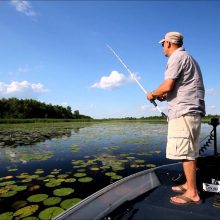This article may contain affiliate links. If you make a purchase after clicking on a link we may earn a small commission at no extra cost to you. As an Amazon Associate, I earn from qualifying purchases.
Flipping and Pitching Setup for Bass

For most anglers the correct flipping and pitching setup will depend entirely on where and what type of lures they will be fishing with.
For the majority of anglers that will mean close quarters work in and around heavy weed beds or other structures like docks.
When working a lure in heavy cover then you really need a rod and line choice that can handle a bass turning it’s nose down into thick vegetation once it is hooked.
Most anglers will use a baitcasting setup, although you could in theory use a spinning outfit for flippin, definitely not for pitching though.
Flipping and Pitching Setup
- Rod – 7’6″ minimum, heavy power rating with a fast action
- Reel – Baitcaster with a high retrieval rate(gearing)
- Line – Braid or Fluorocarbon(heavy braid when in thick weeds)
Rod
The rod will need to be long enough to get a decent amount of line out when flipping and have a fast action so that you can load up the tip to when pitching.
As a general rule look for a flipping rod that is at least 7’6″ in length. You need a decent length rod to be able to get your enough line out off of the spool whilst swinging the lure out in front.
Shorter rods will limit you unless you are only working in extremely short range situations.
When in and around heavy weed cover a heavy action is a must as your rod needs to able to haul bass out from thick weed mats.
A fast action is the preferred choice as it gives you the ability to load the tip when casting and also to set the hook quickly, neither of which is possible with a slower or moderate action.
Reel
When flipping the reel is more or less just a line store so you can either use a spinning reel or a baitcaster.However, you do want a high gear ratio and a baitcaster will generally be the better choice.
A baitcaster is just that little bit easier to use as you will have the reel mounted on the top of the rod making it easier to control the line with your free hand.
When using a spinning reel the bail arm position can also be a bit of a pain to get right, whereas with a casting reel there are no such issues.
When pitching a baitcaster is the only choice in town as you will be pitching the lure out in an underhand casting movement and thumbing the spool as normal to control the casting distance.
Reels with a high retrieval rate are the most popular as you may need to pull a bass out of cover as quickly as possible to prevent them from getting bedded in.
Line
Monofilament is a poor choice and either braid or fluorocarbon are the options.
Mono has far too much in built stretch and when using close up casting techniques you will need to set the hook quickly and firmly, any stretch in your line will delay your strike.
Braid is the best line for flipping and pitching around heavy weeds as it can slice through weed much easier than the same breaking strain of fluorocarbon.
Fluorocarbon is best used when flipping and pitching in more open water or clear water situations as braid is highly visible especially when using topwater lures in summer months.
